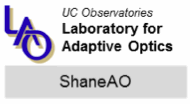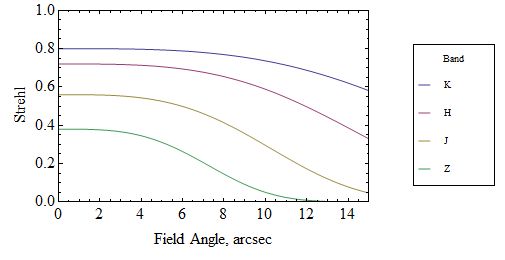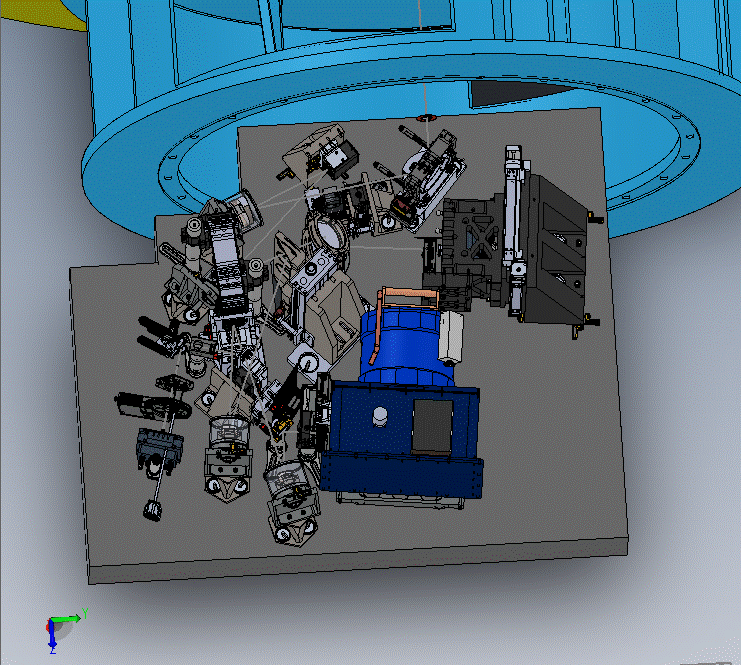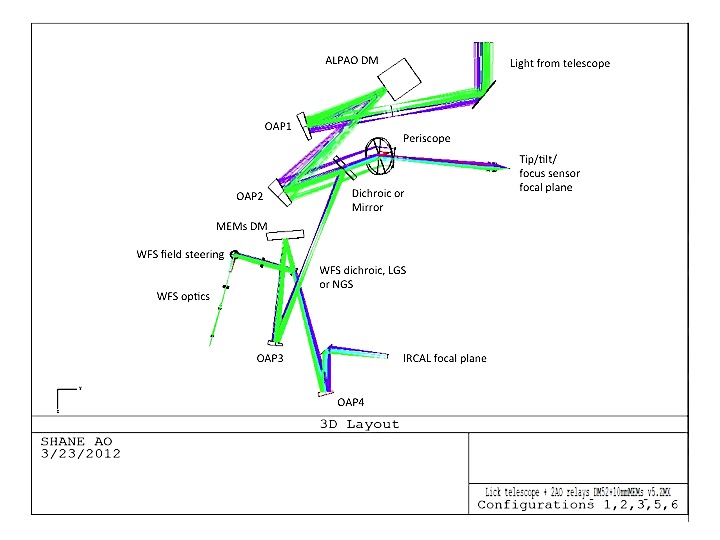
Instrument
What it is
How it works
Science enabled
Observation planning
Publications
Presentations
Documentation
User Docs
Tech Docs (UCO only)
Community
Workshop 12/16
Workshop 12/14
Photos
First Light 4/12/2014 !
People and project
ShaneAO assembly
ShARCS assembly
Mounting on the Telescope
Project
Project reports
People
Videos
Instrument on Telescope
Image Sharpenning
PSF Open/Closed Loop
Wavefronts
Presentations
First Light
Science Publications
Engineering Publications
Talk on AO at OSA

|
|
ShaneAO/ShARCS is a diffraction-limited imager, spectrograph, and polarimeter for the visible and near infrared science bands. It is commissioned and available for science observations at the Shane Telescope. Adaptive optics corrects for the nominally ~1 arcsecond seeing blur over a field of view known as the isoplanatic patch (Figure 1). With the laser guidestar, the system can view any region of sky with performance dependent on proximity of a natural tip/tilt star, airmass, and seeing conditions. ShARCS is the infrared science camera behind the AO system, Shane Adaptive optics infraRed Camera-Spectrograph. |
Science Community |
|
|
|
Figure 1
. Typical NGS Strehl vs field angle.
Baseline Strehls at zero angle are from the ShaneAO nominal
performance budget for LGS mode, 16-subapertures across, r0 = 10 cm
seeing.
|
Table 1. Infrared throughput, emission background, and point source sensitivity.
| J-band | H-band | Ks-band | ||
| Throughput | 17.1% | 19.0% | 21.5% | top of atmosphere to detected photons |
| Emission + Sky | 16.5 | 16.3 | 12.2 | mag/band/as^2 (includes sky OH) |
| Point source sensitivity SNR=5; t=300s | 22.9 | 22.5 | 20.1 | mag |
Table 2. Options available in the aperture and filter wheels of the ShaneAO science camera.
| Aperture | Filter1 | Filter2 |
| Home | Home | Home |
| Pinhole-100 microns | Open | KSiGrism-2 |
| Slit-100 microns-V | J | Wollaston |
| Half-field | H | K |
| Open | Ks | Ch4-2.4 |
| Slit-100 microns-H | H2-2.122 | Ch4-1.2 |
| Finger | BrG-2.16 | Open |
| Open | FeII | Blank25 |
| Blank25 | HGrism |
How it works
The system uses a guide star to probe the atmospheric turbulence at millisecond time scales and corrects for the distorted wavefronts using deformable mirrors. ShaneAO can be used in natural guidestar mode, where a bright natural star is used as the guide star beacon, or laser guidestar mode, in which an artificial guide star beacon is formed in the mesospheric sodium layer using a laser tuned to Sodium’s D2 line. In laser guidestar mode, the system still needs a reference tip/tilt star since the laser’s exact direction is randomized on its upgoing path.
The science camera uses a detector array that samples the field of view at better than Nyquist criterion for diffraction limited PSFs in astronomical J, H, and K bands. The detector is located within a cryogenic dewar that contains a cold pupil stop to baffle out stray light emission. It also contains one aperture wheel and two filter wheels. The aperture wheel contains slits, an occulting finger, and a pinhole. The filter wheels contain a selection of bandpass filters, grisms and a polarization analyzer (Wollaston prism). The filters and apertures available in the dewar are listed in Table 2 Other filters are available (2.2/0.04, H Cont., KCont. ND2).
Optical Layout
Figure 2 shows the path of the light though the AO system and into the science detector.
Figure 2. Layout of the optical bench, shown with support structure removed for visibility (left). The optical path with key elements of the AO system labeled is shown on the right.
Science enabled
Adaptive optics has application to astronomy science programs where measurements and imaging details would otherwise be corrupted by atmospheric seeing blur. Examples of successful AO programs are:
- Crowded field imaging
- Star counts, metallicity and ages in clusters
- Star counts in Andromeda galaxy
- Detailed imaging of nebulae
- Astrometry
- Tracking orbits of stellar companions
- Tracking motion in star clusters
- Extra-galactic
- Velocity dispersion of galaxies hosting active galactic nuclei
- Morphological detail of quasar host galaxies
- Details of morphology of merging galaxies
- Star and star system formation
- Gas and dust disks around young stars
- Multiple star systems in star forming regions
- Exoplanets
- Exoplanets and planet formation statistics
- Follow up to radial velocity planetary systems (stellar companions)
- Follow up to Kepler survey stars (companions)
- Solar System
- Precursory work for Gemini Planet Imager target stars
- Composition and orbital parameters of Kuiper belt objects
- Composition and orbital parameters of asteroids and asteroid moons
- Details of gas-giant ring structure and positions of ring-shepherding moons
- Details and evolution of gas-giant weather
AO is typically not suitable for wide field (>1/2 arcminute) work or large surveys (although a cadence of ~50 objects observed per night is feasible).
AO is not very accurate for aperture photometry in crowded field conditions.
Distinctions to be made between ShaneAO and the older Lick AO system are that the new system has:
- Better long exposure pointing stability to enhance extragalactic science spectroscopy on faint objects
- Higher Strehl performance and finer science camera sampling to extend diffraction limited wavelength coverage to the J and H bands.
- Rotatable slit to enable slit positioning on-sky.
Observing planning and instrument operation
An observer must plan carefully to be sure the system will be able to achieve the measurements desired. Software and staff assistance is available for exposure time calculations and signal-to-noise estimation that will depend on science wavelength, seeing conditions, brightness of target, point like or extended object, etc. In addition to the science targets, the observer may choose to observe reference stars for color, magnitude, and PSF calibrations.
General guidelines for planning:
- A suitably bright natural star for tip/tilt/guiding must be available within 60 arcsec radius of the science target.
- Science targets at low airmass for the duration of observations are preferred , as Strehl degrades proportionally to air mass.
- A nearby star can be chosen for PSF and possibly photometric reference. The best situation is the PSF star is in the science field of view, in which case ~1% photometry is possible. Otherwise the star should be at nearly the same air mass and the observation sequencing should include reasonably frequent nodding to the reference star in order to obtain measurements that track seeing/Strehl conditions.
The AO system and laser are generally operated by an AO specialist and a laser operator respectively. The observer controls the science camera through a graphical user interface . The interface provides setup of exposure times, readout modes, filters, etc. and gives a quick-look visual display of exposures. All operations are automatically logged with time-stamps. Setup information is extensively logged in FITS headers of the science data files. Information about the AO system operating parameters, measured seeing conditions and laser power are also entered in the logs and FITS headers.
Project Reports
Yearly Project Reports to the NSF: 2010 2011 2012 2013
Design Review Presentation (April, 2012)



